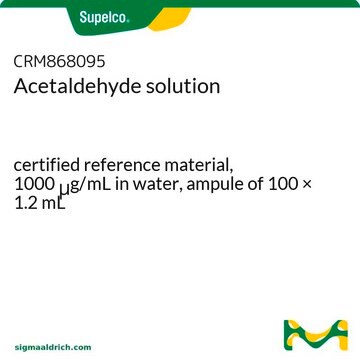W200379
Acetaldehyd -Lösung
40 wt. % in H2O
About This Item
Empfohlene Produkte
Biologische Quelle
synthetic
Qualitätsniveau
Einhaltung gesetzlicher Vorschriften
FDA 21 CFR 177.2410
FDA 21 CFR 182.60
Form
liquid
Konzentration
35.00-45.00% (titration by hydroxylamine)
40 wt. % in H2O
Brechungsindex
n20/D 1.3771
Dichte
0.868 g/mL at 20 °C
Anwendung(en)
flavors and fragrances
Dokumentation
see Safety & Documentation for available documents
Nahrungsmittelallergen
no known allergens
Organoleptisch
ethereal
SMILES String
[H]C(C)=O
InChI
1S/C2H4O/c1-2-3/h2H,1H3
InChIKey
IKHGUXGNUITLKF-UHFFFAOYSA-N
Suchen Sie nach ähnlichen Produkten? Aufrufen Leitfaden zum Produktvergleich
Haftungsausschluss
Vergleichbares Produkt
Signalwort
Danger
H-Sätze
Gefahreneinstufungen
Carc. 1B - Eye Irrit. 2 - Flam. Liq. 2 - Muta. 2 - STOT SE 3
Zielorgane
Respiratory system
Lagerklassenschlüssel
3 - Flammable liquids
WGK
WGK 3
Flammpunkt (°F)
<-0.0 °F - closed cup
Flammpunkt (°C)
< -17.78 °C - closed cup
Persönliche Schutzausrüstung
Eyeshields, Faceshields, Gloves, type ABEK (EN14387) respirator filter
Hier finden Sie alle aktuellen Versionen:
Besitzen Sie dieses Produkt bereits?
In der Dokumentenbibliothek finden Sie die Dokumentation zu den Produkten, die Sie kürzlich erworben haben.
Kunden haben sich ebenfalls angesehen
Unser Team von Wissenschaftlern verfügt über Erfahrung in allen Forschungsbereichen einschließlich Life Science, Materialwissenschaften, chemischer Synthese, Chromatographie, Analytik und vielen mehr..
Setzen Sie sich mit dem technischen Dienst in Verbindung.




